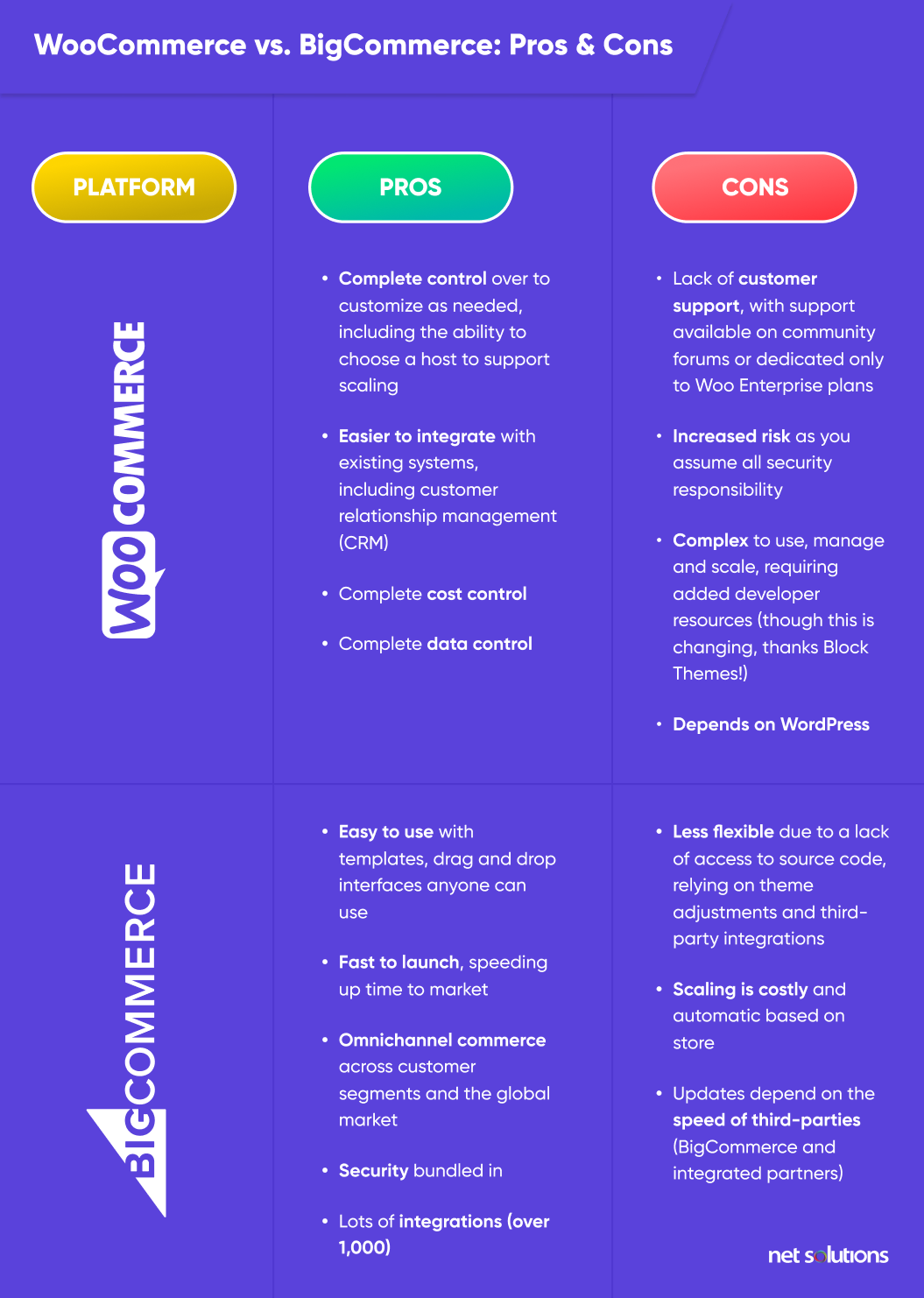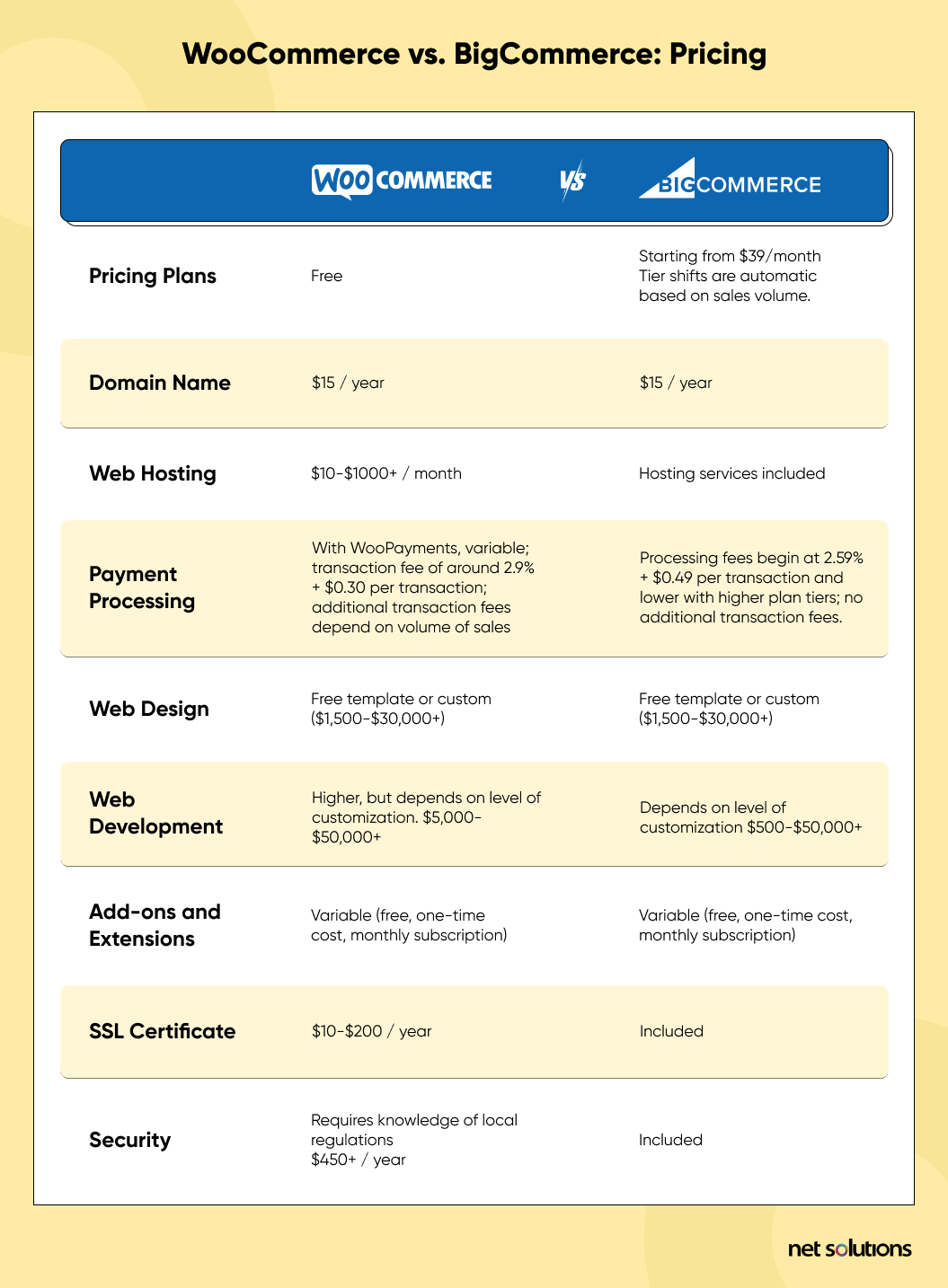For small or medium-sized local business owners, individuals, or startup founders looking to launch or grow an online-only business, it is important to choose an eCommerce platform that is easy-to-use, has robust and secure features, that can scale as you grow, and is cost-effective.
While it can be overwhelming to note the variety of eCommerce platforms, we’re going to narrow down to the top two choices that are ideal for individuals and businesses:
WooCommerce and BigCommerce. The main difference between WooCommerce and BigCommerce is that WooCommerce is open-source (unhosted) and BigCommerce is software-as-a-service (SaaS, hosted).
In this guide, you will find a full comparison between WooCommerce and BigCommerce, talking about:
- Ease of use
- Features
- Scalability
- Pricing
- The pros and cons of hosted vs open-source tools
This guide will walk you through a high level discussion of each eCommerce platform to help launch an online store followed by an in-depth analysis of each decision factor to help you make an informed decision that supports your digital commerce goals and captures the opportunities from the latest eCommerce trends in 2025.
What is a SaaS vs Open-Source eCommerce Platform?
If you are struggling with the decision between open-source and SaaS, it’s first to understand the pros and cons of a hosted (SaaS) vs an unhosted (open-source) eCommerce solution:
Software as a service (SaaS) is software that is hosted by a third-party in the cloud. SaaS eCommerce platforms such as BigCommerce provide access to software to design online stores all from the convenience of a web browser. SaaS bundles software maintenance, hosting, security, performance and customer service into a monthly or yearly cost, with potential additional costs for integrations
Open-source software such as WooCommerce is software code that has been developed and released for free to allow companies to have complete control over developing, customizing, launching and maintaining their online stores. Open-source software code is free, but all subsequent development, maintenance, hosting or integrations would have additional costs and complexities.

WooCommerce vs. BigCommerce: Pros & Cons
To assist small to medium-sized business owners, startup founders, digital marketers, eCommerce managers, and consultants in navigating the complexities of choosing an e-commerce platform that best suits their operational needs, budget constraints, and growth ambitions, let’s break down the pros and cons of WooCommerce vs BigCommerce.
As noted, the biggest difference between the two eCommerce platforms is that WooCommerce is open-source while BigCommerce is SaaS, pitting free and customizable vs paid and easy. Of course, there’s a lot of nuance to this. Even a ‘free’ platform will have a lot of actual costs, so it’s important to consider the total cost of ownership of each platform option, including hosting, maintenance, hidden fees, add-ons and integration expenses.
So, let’s start with a simple comparison of WooCommerce and BigCommerce, highlighting key pros and cons, which includes elements of all the important deciding factors across features, pricing, user experience and scalability.

Advantages and disadvantages of WooCommerce
WooCommerce is an open-source plugin for the open-source content management system (CMS) WordPress, so both are required elements in this discussion. WooCommerce was first developed by WooThemes, initially released in 2011 and acquired by Automattic, the operator of WordPress in 2015. Today, the WooCommerce open-source WordPress plugin is used by 3.9 million online stores, powering 23% of the top 1 million eCommerce sites.* Woo Enterprise is an add-on service that adds some dedicated customer service to support organizations.
Recently, Automattic has made the decision to refer to the WooCommerce brand by “Woo” while continuing to identify the eCommerce platform as WooCommerce.
Advantages of WooCommerce
As an open-source platform, WooCommerce offers the greatest amount of control over pricing and customization:
- Complete control, both over source code to customize as needed as well as in choice of hosting to optimize performance and scale as needed
- Complete cost control, to only pay for what you need
- Easier to integrate with existing systems, including customer relationship management (CRM)
- Complete data control because you own and store your own data
Disadvantages of WooCommerce
As an open-source platform, the flip side of control is a need to do more, increasing development time and cost as well as risk:
- Lack of customer support, with WooCommerce support available on community forums or dedicated only to Woo Enterprise plans
- Increased risk as you assume all security and maintenance responsibility and need to know a lot about international markets to scale globally
- Complex to use, manage and scale, requiring added developer resources (note: Block Themes are trying to solve this!)
- Is dependent upon WordPress, limiting flexibility to other CMS options
Is WooCommerce the right fit for you?
WooCommerce is an ideal solution for:
- Brands with existing WordPress sites who want to offer B2B or B2C purchasing
- Small to enterprise clients
- Those with large SKUs, since it supports unlimited products
- Those who need better cost control (unlimited transactions)
- Those who want greater customization capabilities
- Service-based businesses (selling, booking)
- Digital product sales
- Subscriptions
Advantages and Disadvantages of BigCommerce
BigCommerce is one of the most popular cloud-based eCommerce platforms, known to be very user friendly and easy to get started.
Advantages of BigCommerce
- Easy to use with templates, drag and drop interfaces anyone can use
- Fast to launch, speeding up time to market
- Security bundled in
- Lots of BigCommerce apps and integrations (over 1,000)
- Omnichannel commerce is supported across B2C and B2B, mobile and international,
Disadvantages of BigCommerce
- Less flexible due to a lack of access to source code, relying on theme adjustments and third-party integrations
- Scaling is costly and automatic based on store, so margins can get pinched unexpectedly
- Updates depend on the speed of third-parties (BigCommerce and integrated partners)
Is BigCommerce the right fit for you?
BigCommerce development services are ideal for:
- Small to enterprise level clients
- B2B, B2C and wholesale clients
- Brands who want to deliver an omnichannel experience
- Companies who want a hosted solution with built-in security and reliable 99.99% uptime
- Those who want a headless solution
- Brands who need multi-store capabilities from a single interface
WooCommerce vs BigCommerce: Full Comparison
Depending on whether you’re selling to consumers or if you operate a B2B eCommerce business, you’ll have a set of requirements that a platform should meet that align with your needs, preferences, and available resources. Let’s dig into those in detail:
User-friendliness
The critical factors that make an eCommerce platform easy are the dashboard and the availability of high-quality templates. For this, BigCommerce is the winner with all its built-in features (though WooCommerce is catching up!).
BigCommerce has an easy-to-use dashboard with many built-in tools to streamline creating a new online store. There are 241 free and premium themes available to help individuals and small businesses get started quickly. BigCommerce is considered a low code /no code website builder.
WooCommerce is often chosen for the developer freedom to customize deeply via code, but WooCommerce now has the option for low code development using Block Themes.
Customization options
While BigCommerce has many out-of-the-box solutions, the winner for customization is WooCommerce.
BigCommerce is a headless solution, allowing you to choose the front-end frameworks and connect to backends, including WordPress, but in a much more straightforward way than you would be able to set up WooCommerce as a headless solution. BigCommerce customization is limited to what the theme may allow or leveraging integrations and extensions. There is also the ability to write custom elements via high-extensibility APIs. Browse BigCommerce themes here.
WooCommerce allows a deeper code-level customization across the entire platform, from design and hosting to free and paid extensions, themes and plugins. This requires more up-front developer time and knowledge, but there are no limits to what customizations can achieve. Browse WooCommerce themes here.
Development duration
The clear winner here is BigCommerce, since it offers a greater amount of out-of-the-box features and does not require any up-front time to choose hosting, set up security, etc. Developers can add integrations or create custom themes, a hosted site attempts to minimize development time to speed time-to-market.
For WooCommerce, individuals and small businesses can leverage some of the templates on the marketplace and the new Block Theme elements, but developers are not ‘optional’ to set up, launch or maintain a WooCommerce site, increasing time-to-market for a WooCommerce site.
For organizations that lack in-house expertise for WooCommerce or BigCommerce, it’s important to set up a strong relationship with a trusted eCommerce partner.
eCommerce capabilities & functions
To be able to sell online, you need a variety of eCommerce features to manage inventory, shipping, payments and more. While BigCommerce has the most built-in features, let’s break down the core eCommerce functionality of each platform:
- Inventory management – BigCommerce wins with native support for unlimited products, inventory management, and the ability to sync inventory across locations (with POS add-on) while WooCommerce requires integration with a CMS or plugin for these features.
- Shipping – Equal. Both platforms offer built-in options for shipping with additional integrations for more advanced shipping.
- Channels – Equal. Both BigCommerce and WooCommerce offer native or third-party tools to support multi-channel commerce through marketplaces such as Amazon, eBay or social media as well as third-party integration for in-person support. WooPayment has its own POS, BigCommerce does not.
- Payment options – See below.
- SEO tools – See below.
Extensions and integration possibilities
It is important to choose an eCommerce platform that is able to integrate seamlessly with existing systems such as inventory management or customer relationship management (CRM) tools. Look carefully at any out-of-the-box APIs that connect your systems or your ability to create necessary system APIs to establish connections. Further, each eCommerce platform will have a number of other services it works well with, appearing as extensions, plugins, or available integrations across critical eCommerce areas such as payment gateways, shipping and fulfillment, recommendation engines, chat, analytics, inventory management, POS integration, marketing, security and more.
BigCommerce has over 1,000 third-party apps in its BigCommerce store.
WooCommerce lists only a handful of officially supported extensions, many extensions and third-party plugins will also work with WooCommerce and are listed on the WooCommerce Marketplace.
Promotional and marketing features
The ability to deliver a seamless digital customer experience is essential when choosing an eCommerce platform. For this, both platforms rely extensively on additional marketing tools, so it’s a tie between BigCommerce and WooCommerce.
BigCommerce offers more built-in marketing (SEO, social media integration) but relies on 258 listed marketing apps to extend capabilities into areas such as email marketing, coupons, gifting, points and more, including the integration with third-party CRM tools such as G Suite or MailChimp.
Woo has created a series of marketing integrations to support WooCommerce including abandon cart recovery, powerful automations to engage customers, email newsletter integrations, coupon, gifting, points and reward options.
Payment methods and associated costs
Although both offer online and in-person payment support, BigCommerce offers slightly more advantageous processing rates thanks to the partnerships it curates.
WooCommerce can handle online and in-person payments via WooPayments, with online costs starting at 2.9% + $0.30 per transaction, although costs vary per country (38 countries and 135 currencies supported) and with volume of sales. Other payment gateways are available through plugins.
For BigCommerce, processing fees begin at 2.59% and $0.49, going down with higher tiered plans. BigCommerce supports over 65 integrations with payment processors, including PayPal, Stripe and Apple Pay.
Search engine optimization (SEO)
eCommerce store success relies on attracting customers, which is supported by SEO. There are many factors that influence SEO, with BigCommerce offering more out-of-the-box capabilities and both platforms offering a range of plugins to satisfy SEO optimization. This is a tie between WooCommerce vs BigCommerce.
Support and assistance
Customer support brings Big Commerce as the winner in this category, offering customer support across phone, email and chat to any price plan, while WooCommerce base support comes from a community forum.
At the enterprise level, both Big Commerce and Woo Enterprise offer more dedicated support.
Scaling
Organizations want scalable solutions that support business growth to avoid future migration headaches. While both solutions are scalable to enterprise growth, the winner is WooCommerce.
BigCommerce is known for its high uptime, unlimited bandwidth and flexible infrastructure. For WooCommerce, more is in your control for performance, so you can scale quickly with greater control over costs, as hosting plans and optimizations are something within your control.
Security
It’s critical to ensure the chosen platform provides robust security features to protect against online threats and fraud. The winner for this category is BigCommerce, which provides security features in the platform.
BigCommerce is certified with PCI-DSS, SOC, FIPS 140-2, and ISO/IEC 27001. It offers role-based access controls, audit logs, and automatic security updates.
For the WooCommerce plugin, you’ll have to set up security on your own, requiring knowledge of local privacy and security regulations in every country you sell to as well as knowledge of eCommerce security and security notification requirements. Considerations include:
- SSL certificates
- Firewalls
- Virus and anti-malware
- Spam filters
- Domain name privacy
- DDos protection
- Access controls and multi-factor authentication (users and admins)
- Encryption
- Backup
- Network monitoring
- Auditing
- Compliance requirements
- Secure payment gateways
Pricing
Pricing comparisons between BigCommerce and WooCommerce needs to look beyond just the base cose (BigCommerce price tiers vs WooCommerce being free) to consider the total cost to launch a custom eCommerce website as well as the total cost of ownership. For control over costs at a granular level, WooCommerce wins this category.
BigCommerce pricing plans
BigCommerce is a hosted platform, offering all-in-one services to manage and secure online stores without hassle, with pricing adjusting to the next pricing tier automatically (each tier opening up incremental benefits in credit card rate, search and cart capabilities). BigCommerce plans are by a monthly fee or annual fee.
- BigCommerce Standard Plan – $29 / mo
Unlimited number of goods, unlimited staff accounts, includes blog. - BigCommerce Plus Plan – $79 / mo
The plus plan is designed for small business sales up to $180k annually, new features for abandoned cart, segmentation and stored credit cards. - BigCommerce Pro Plan – $299 / mo+
Designed for sales up to $400k annually, new features for search and SSL. - BigCommerce Enterprise Plan – variable, $1000+ / mo
Offers more flexibility through unlimited API calls, unrestricted GMV limits, priority routing and support, and more customizations.
WooCommerce pricing
As noted, WooCommerce is an open-source free plugin for WordPress sites. Both WooCommerce and WordPress are offered free to download and use on the hosting provider of your choice. The cost to develop, host and customize an open-source platform incurs additional cost each year that can equal or exceed the cost of a bundled price plan.
- WooCommerce standard – FREE
- Woo Enterprise plans – (custom)
Woo Enterprise is a service offered to high-volume stores that includes a dedicated success manager, priority support, store migration assistance and discounted hosting.
Some hosting providers (e.g. Bluehost) offer customized WooCommerce plans that bundle hosting with additional WooCommerce tools, plugins and professional services to mimic the features of SaaS, offloading tasks such as site updates or backups. Note, few of these bundled plans support enterprise-level capabilities since most enterprises choosing WooCommerce want full control.
Total cost of ownership of your storefront
When launching a BigCommerce store or a WooCommerce store, there are other costs to be considered, some of which are bundled into the monthly of annual costs of a price plan (above) for BigCommerce, and some of which apply to either eCommerce platform.

The determination of which option is most cost-effective depends on the size of the store, the features (plugins, extensions) chosen, whether you use a free theme or custom theme, and ultimately the level of custom development that occurs to set up or change the storefront over time. One of the benefits of WooCommerce is the ability to pay for only those features you need.
BigCommerce vs. WooCommerce: What Users Have to Say
While we have worked to create a comparison of eCommerce platforms that is as free from bias as possible, we also want to share with you some examples of what others have to say about BigCommerce vs WooCommerce. This represents real reviews left on G2, a peer-to-peer review site.
What do users have to say about WooCommerce?
Users generally say that WooCommerce is easy to use, has plugin flexibility, a range of eCommerce services, easy integration, and a range of customizations:
Pros:
- “I use WooCommerce as a robust integration with WordPress. In general, the software is user-friendly and a shop can be operated and run as a non-developer. Its wide range of customisable features and extensions make it ideal for my e-commerce needs. Due to the large community, you find quickly help or resources like training videos or forums.” – Eva E.
- “We use it on a regular basis. WooCommerce stands out for its seamless integration within WordPress, boasting an intuitive setup wizard and diverse payment gateway options. Its compatibility with almost all the site editors without extra plugins is a boon. It provides various hooks to customize the behavior for a specific user based on their needs.
Thanks to its open source environment it has the best online support. The robust support for sales statistics across various timeframes and the effortless transition between physical and digital product creation, along with its extensive integration capabilities with shipping, inventory, CRM, and email marketing applications, truly redefine the online retail experience. Its ability to transform websites into cost-effective, versatile online stores while offering an extensive array of connections remains its unparalleled strength, making WooCommerce an invaluable asset for businesses seeking an efficient, adaptable e-commerce solution.“ – Vipul
- “WooCommerce is super easy to use with WordPress. making it a easy task to set up my online store. The design is simple, and I can customize everything the way I want. Managing products, inventory, and orders is flexible, giving my customers a personalized shopping experience. Plus, there are tons of plugins that make WooCommerce the perfect choice for creating and managing my e-commerce site effortlessly.” – Arun K.
Users say that WooCommerce can become expensive, has some limitations, has a high learning curve, slow performance and can be limited for customizations:
Cons:
- “The extensions are all priced with a SaaS model, sometimes pretty high, and you do not get much customer support. Which could be frustrating if you are a newbie to the WP echosystem. [sic.]” – Francesco G.
- “WooCommerce’s scalability for larger online stores, as performance issues might arise with a significant number of products and customers. Additionally, setting up and configuring advanced features can be daunting for those with limited technical knowledge. Lastly, occasional compatibility issues between WooCommerce and certain WordPress themes or plugins have been reported, requiring troubleshooting.” – Tahir M.
- “While WooCommerce excels in versatility, its complexity can, especially during integrations be overwhelming. I would not recommend implementing without experience. You need a lot of additional plugins and also some clue about local regulations in e-commerce as WooCommerce is an international tool and you need to customize it with configurations or with additional modules to make it compliant. Don´t underestimate the costs of setup and operations.” – Eva E.
What do users have to say about BigCommerce?
Users generally say that BigCommerce is easy to use, has great customer support, supports online sales, and is good for e-Commerce services.
Pros:
- “BigCommerce is very much that – big. The possibilities are nigh on endless, particularly when partnering with a development agency specialising in BC. There’s clearly a drive by BC towards empowering their merchants to go global with lots of tools to make international selling easy. The platform itself is easy to use on a day to day basis, and the customer support is excellent with quick response times and largely quick solutions. The number of integrations with third party platforms is really quite impressive offering lots of choice.” – Luke R.
- “It’s very good for small retail business who want to jump in online business. Security, payment & checkout process are very smooth and easy.” – Krunal
- “BigCommerce has been instrumental in our development since day 1. To TYLER’S, BigCommerce isn’t just a SAAS platform, they’re coaches, mentors, friends, and counselors. We’re best at being a specialized retailer and have spent 40 years navigating the physical store side, but are still fairly young and new in the online world. BigCommerce helps us understand the mechanisms to be more competitive in the ecommerce space, which spills over into our stores through implementations directed towards an omnichannel experience. They know our goals and resolutions and even in the worst case scenario of not knowing the answer to something, they find someone who does.” – Justin D.
Users list some issues with customer support, limited customizations, limitations, expensive or billing issues.
Cons:
- “Analytics could be more maleable. Sometimes the platform feels too powerful for our smaller side projects. Working with a development agency or having a developer on the team is very much required with BigCommerce – sometimes even what feel like the simplest of projects require a deep knowledge of APIs etc” – Luke R.
- “You do not get to speak to developers about your issues, only support staff and their multi store product is not fully developed yet and has lots of snags and issues.” – Alishia W.
- “Status codes can’t be customized to your specific business. Blogging system is very limited. When our sales went up, our pricing jumped up without warning and was not negotiable. BigCommerce is not good for businesses with slim margins.” – Richard R.
The Bottom Line
Selecting the best eCommerce platform is a critical decision for any online business, impacting how easy it is to get to market, scale, and support the customer experience. Choosing the right platform isn’t easy, but we hope this guide has helped.
What is WooCommerce best for?
WooCommerce is ideal if you want to or already use WordPress, integrating seamlessly, or are a large store that requires greater control over hosting, performance, or customization options.
What is BigCommerce best for?
BigCommerce is a hosted solution, ideal for customers that want a simplified, all-in-one-solution, who want to accelerate time-to-market, want more flexibility for headless commerce, or who want added levels of support.
Are You Ready To Get Started?
At Net Solutions, we have experience working alongside customers to help navigate this complex decision to choose the right platform for your eCommerce business and in optimizing your platform with the right eCommerce plugin and custom features to deliver results and delight customers. We can also offer migration support, security analysis, and managed services to help your online store grow and succeed well into the future.

![Header Image_WooCommerce vs. BigCommerce in 2025 [Detailed Comparison]](https://www.netsolutions.com/wp-content/uploads/2024/06/Header-Image_WooCommerce-vs.-BigCommerce-in-2025-Detailed-Comparison.webp)



